
Our aim goes far beyond delving into recipes and teaching culinary techniques; we intend to promote sustainable eating as an essential part of preserving humans’ relationship with nature. As such, we invite anyone who shares this same conviction or has a secret family recipe they would like to share with the rest of us to visit us online or contact us at [email protected] for all collaborations and submissions. Let’s show appreciation for those that dedicate their lives using natural deliciousness to establish meaningful human bonds through cuisine!
Now love yourself and enjoy this one ...
I’ve really been digging cheese tortellini lately because it’s as easy as plain pasta, but it’s just a bit more hearty (thanks to that cheese filling), so it instantly makes any pasta dish feel more substantial, even without adding meat. Last week I made this super easy Spinach Tortellini Skillet, which is a riff on one of our most popular recipes, Creamy Tomato and Spinach Pasta. This tortellini version is a bit easier (no chopping onion!) and a little more filling. I hope you enjoy!

What’s in This Tortellini SKillet
This recipe is incredibly simple, which makes it the perfect easy weeknight dinner. It’s got cheesy tortellini that we toss in a homemade creamy tomato sauce, and a couple of handfuls of fresh spinach thrown in for color, texture, and nutrients. The only ingredients you need to make this delicious pasta skillet are:
- Herbs and spices: We kept the sauce pretty simple as far as seasonings go, with just some fresh garlic, dried basil, dried oregano, and freshly cracked pepper.
- Diced tomatoes: We opted for petite diced tomatoes here to keep the sauce from being too chunky. You could also use fire-roasted diced tomatoes for more flavor!
- Cream cheese: This instantly gives the tomato sauce a thick and creamy texture which coats the tortellini beautifully.
- Cheese tortellini: We used frozen cheese tortellini, which cooks quickly (about 3 min.), but you can use whatever flavor or type of tortellini you prefer.
- Parmesan cheese: A little Parmesan cheese at the end really helps boost the umami flavor in the skillet, and adds a little extra richness to the sauce.
- Fresh spinach: A few handfuls of fresh spinach thrown into the sauce gives this dish a beautiful dose of color and a little extra veggie power.
What Else Can I Add?
I think this dish is pretty hearty as-is, but if you want to add some meat you have several options. You could brown some Italian Sausage in the skillet before the garlic and incorporate it into the sauce, you could top the skillet with some sliced seared chicken breast, or you could even add some garlic butter shrimp!
If you like your food spicy, definitely add a pinch or two of crushed red pepper to the tomato sauce for a little kick. And if you want this to be EXTRA indulgent, try topping it with some mozzarella and baking it in the oven until melted! 😮
What to Serve with This Tortellini Skillet
GARLIC BREAD. This recipe is just begging for some buttery, crispy, homemade garlic bread! And if you’re like me, you already have some stashed in your freezer ready to bake on a moment’s notice. ;) And if you want some extra veggies with this meal, you can use any leftover spinach you might have to make a simple side salad. Or make some easy roasted broccoli to serve on the side!
How are the LEftovers?
Fan-freaking-tastic, IMHO! The sauce does get a little thick with time in the refrigerator, but that does not impede on the cozy, cheesy goodness of this dish. The microwave is going to be your best bet for reheating the leftovers as it will reheat quickly without losing too much moisture. Make sure to keep the dish partially covered to hold in the steam, and stir occasionally to help it reheat evenly.
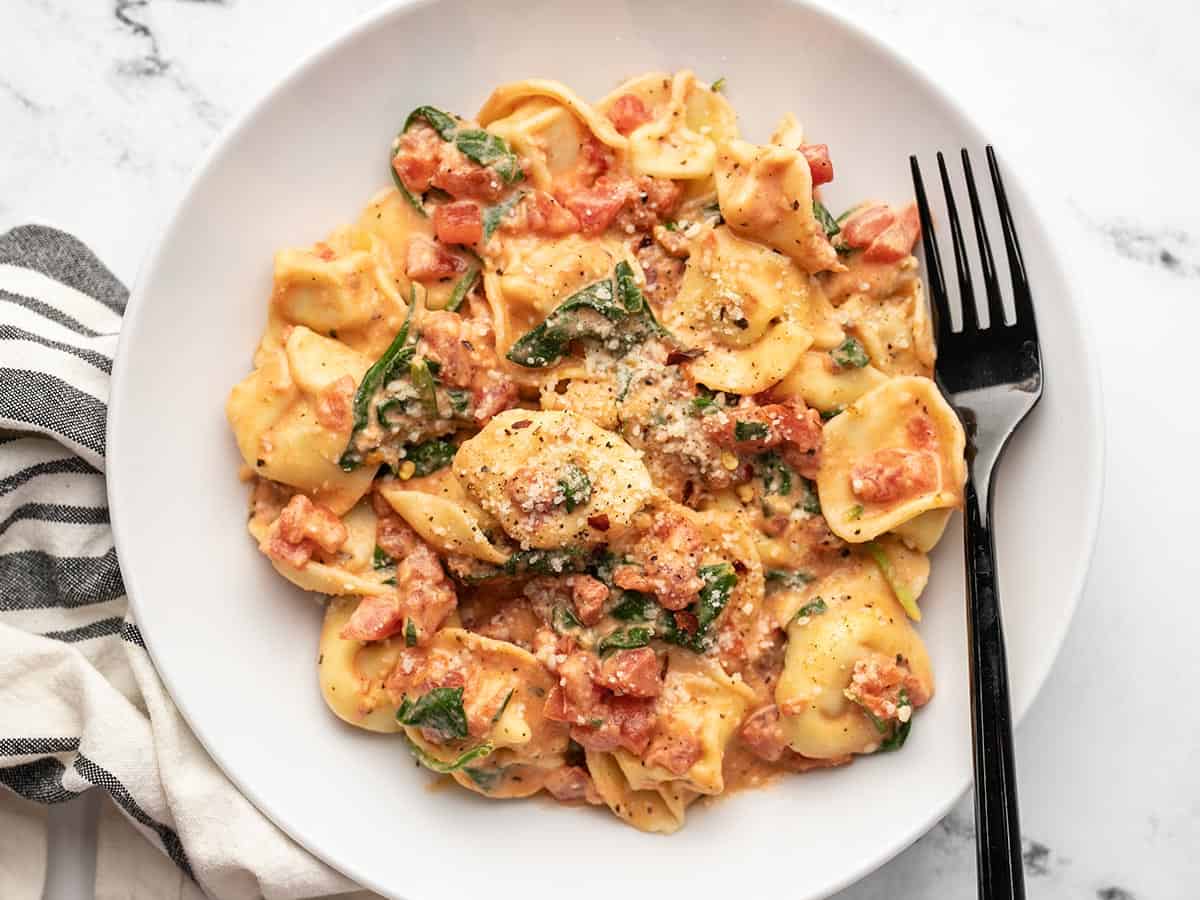

Spinach Tortellini Skillet
Ingredients
- 4 cloves garlic $0.32
- 1 Tbsp olive oil $0.13
- 1 28oz. can petite diced tomatoes $1.69
- 1/2 tsp dried basil $0.05
- 1/2 tsp dried oregano $0.05
- 1/4 tsp Freshly cracked pepper $0.02
- 4 oz. cream cheese $1.10
- 19 oz. frozen cheese tortellini $4.79
- 2 cups fresh spinach $0.60
- 1/4 cup grated Parmesan $0.36
Instructions
- Mince the garlic and add it to a large skillet with the olive oil. Sauté the garlic over medium heat for about one minute, or just until it becomes fragrant.
- Add the diced tomatoes (with juices), basil, oregano, and pepper to the skillet. Stir to combine and continue to cook and stir until the tomatoes are hot.
- Cut the cream cheese into chunks, then add it to the hot tomato sauce in the skillet. Continue to cook and stir until the cream cheese has melted into the tomatoes and created a smooth and creamy sauce (use a whisk, if needed).
- Meanwhile, bring a large pot of water to a boil for the tortellini. Once boiling, add the tortellini and continue to boil for about three minutes, or until they are all floating (make sure to check the package instructions for the recommended cook time). Drain the tortellini in a colander.
- While the tortellini is draining, roughly chop the spinach into bite-sized pieces. Add the chopped spinach to the sauce in the skillet and stir to combine, allowing the heat to wilt the spinach.
- Add the drained tortellini to the skillet and stir to combine with the sauce.
- Sprinkle the Parmesan over top and stir to combine. Give the tortellini a taste and adjust any salt or seasonings to your liking. Serve hot and enjoy!
See how we calculate recipe costs here.
Nutrition
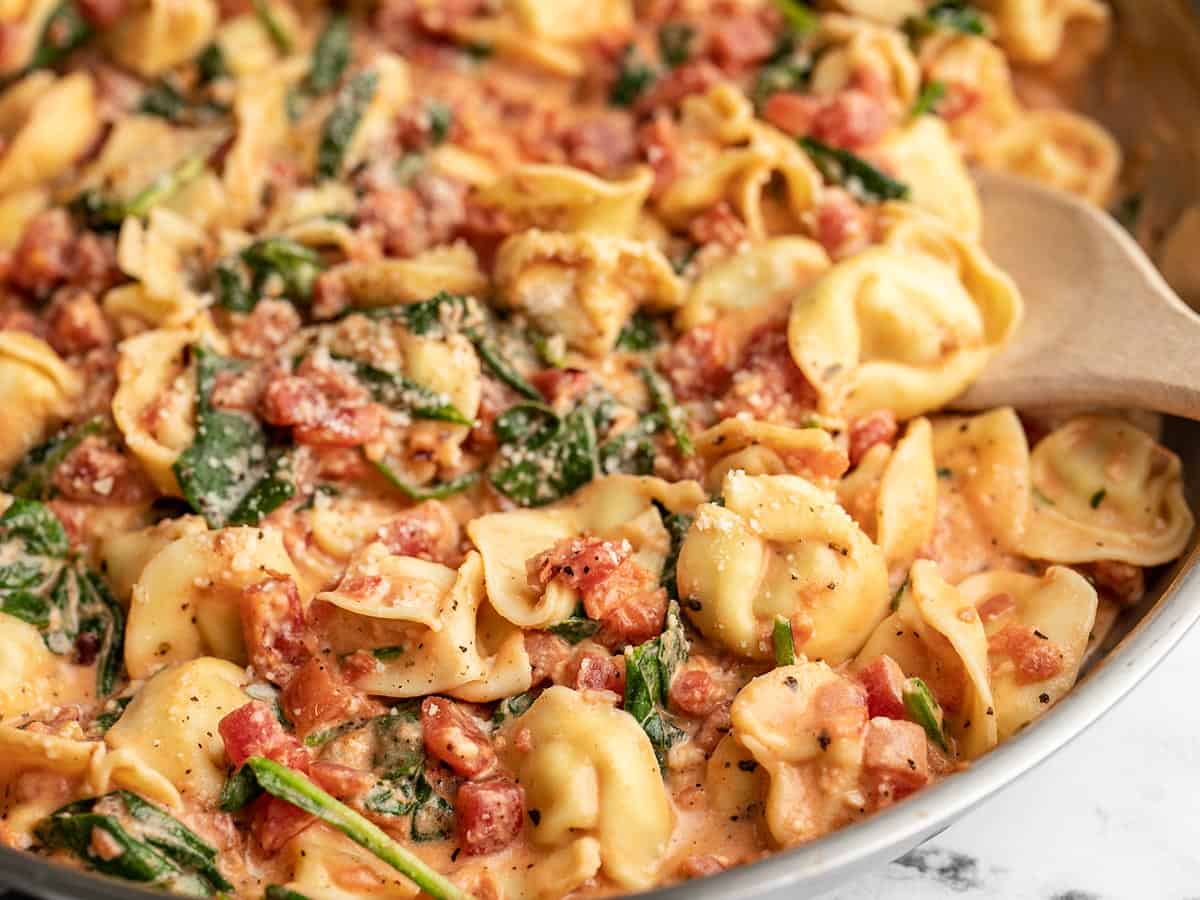
How to Make Spinach Tortellini Skillet - Step by Step Photos
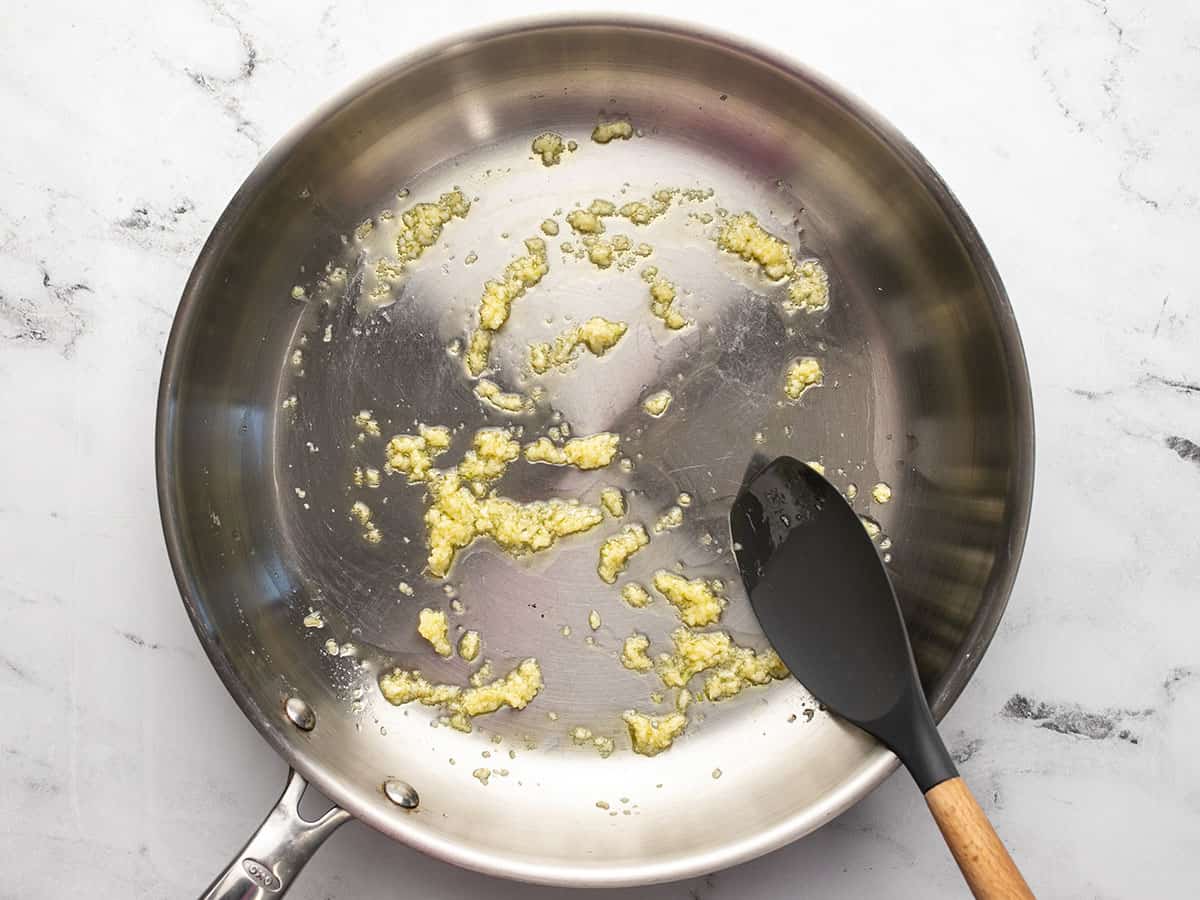
Mince four cloves of garlic, then add them to a large skillet with 1 Tbsp olive oil. Sauté the garlic over medium heat for about one minute, or just until the garlic becomes fragrant.
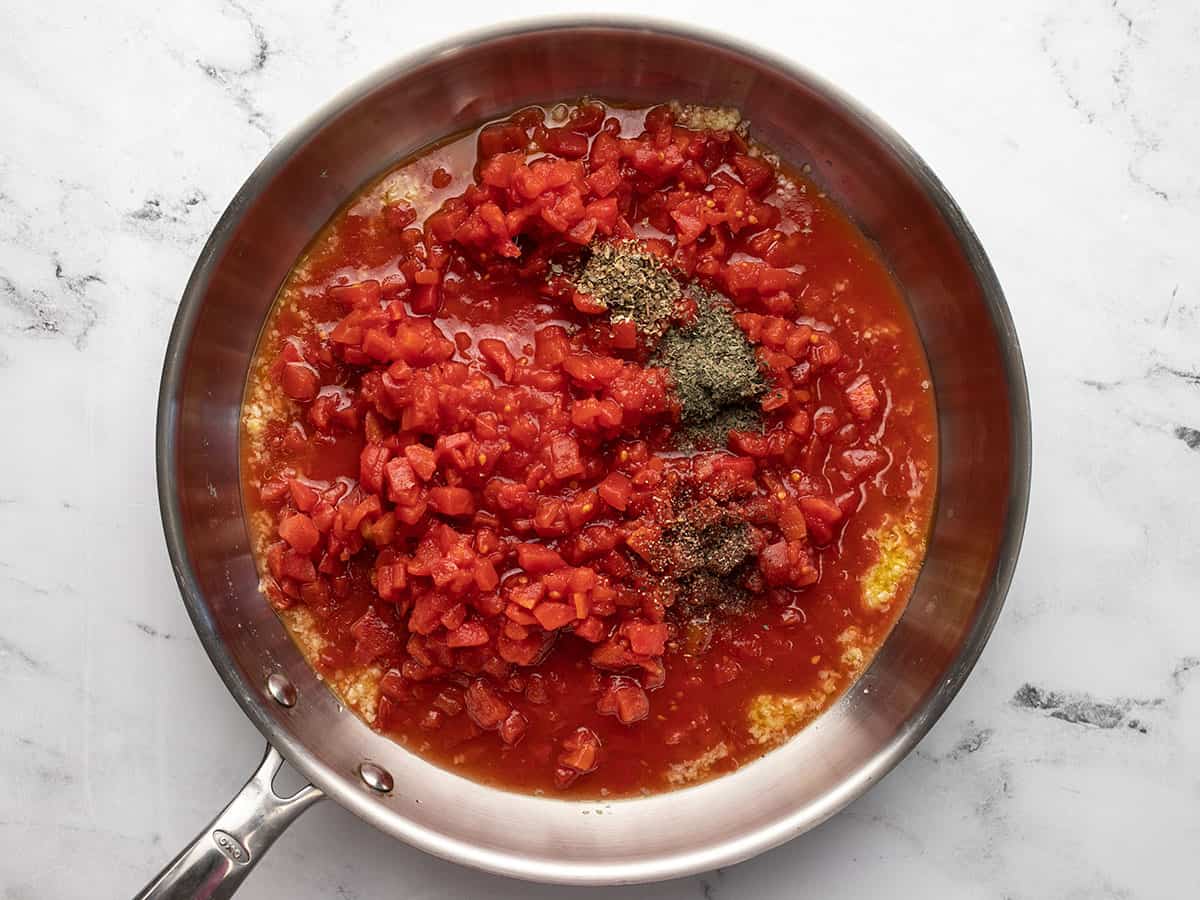
Add one 28oz. can of petite diced tomatoes to the skillet (with the juices), along with ½ tsp dried basil, ½ tsp dried oregano, and ¼ tsp freshly cracked pepper. Stir the ingredients together and continue to heat over medium, stirring occasionally.
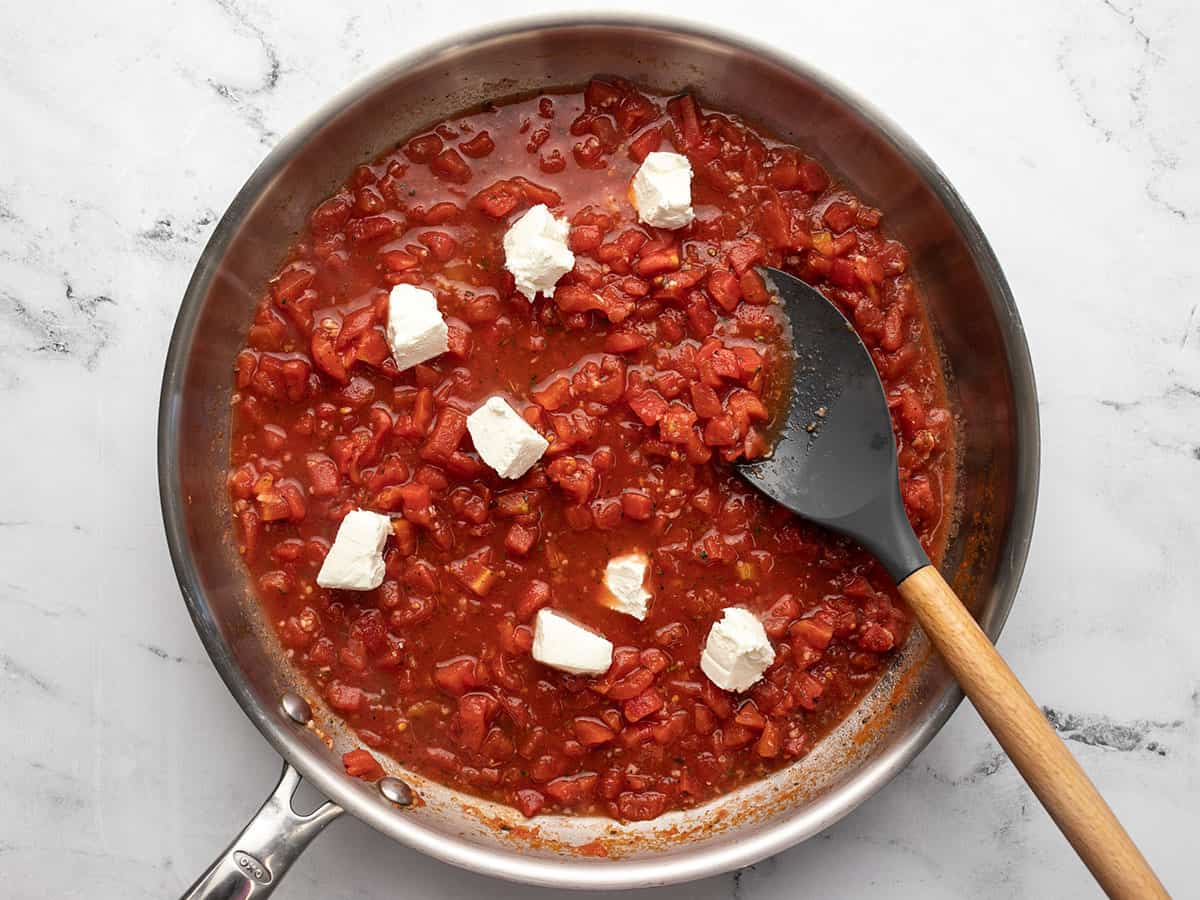
Once the tomatoes are hot, cut 4 oz. of cream cheese into chunks, then add it to the skillet.
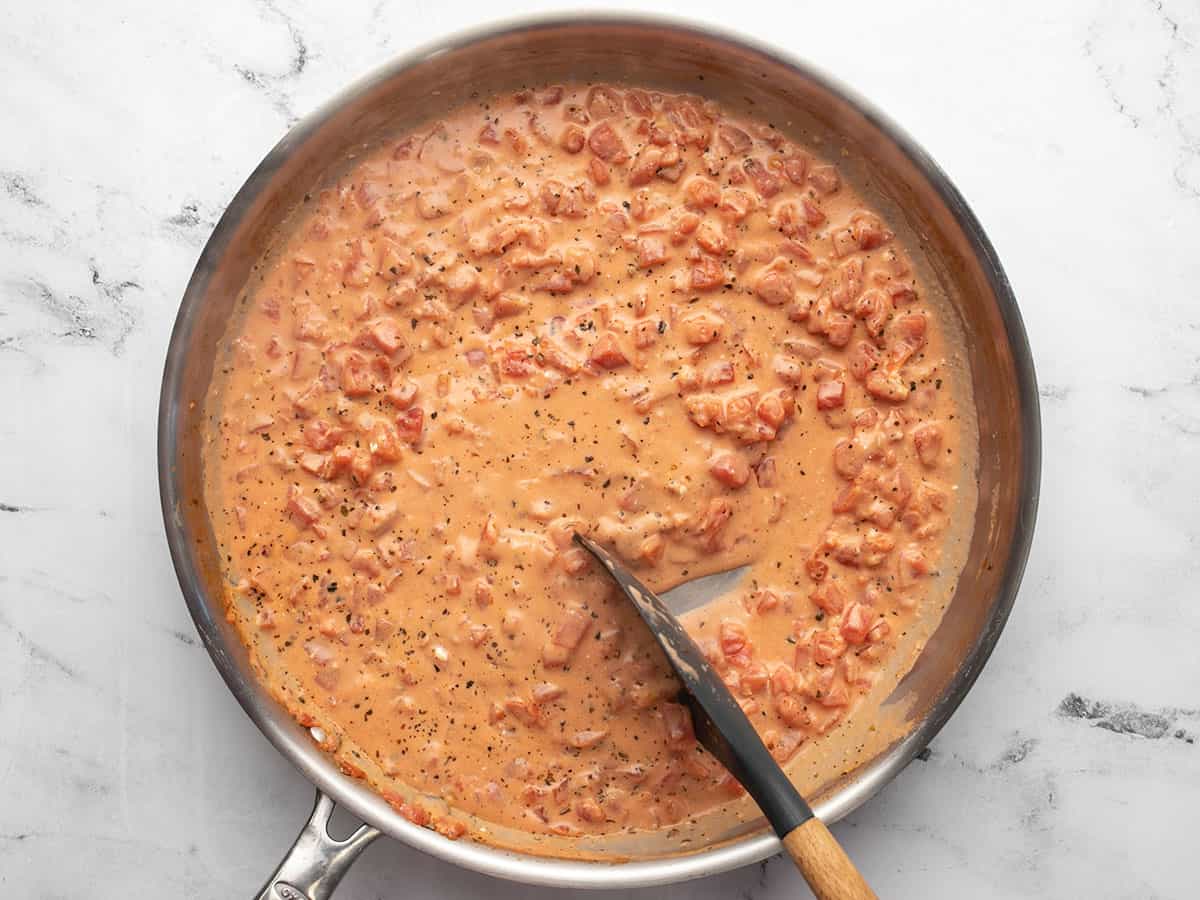
Continue to cook and stir the sauce over medium heat until the cream cheese has melted in and created a smooth and creamy sauce. You can use a whisk, if needed, to help the cream cheese melt into the sauce well.
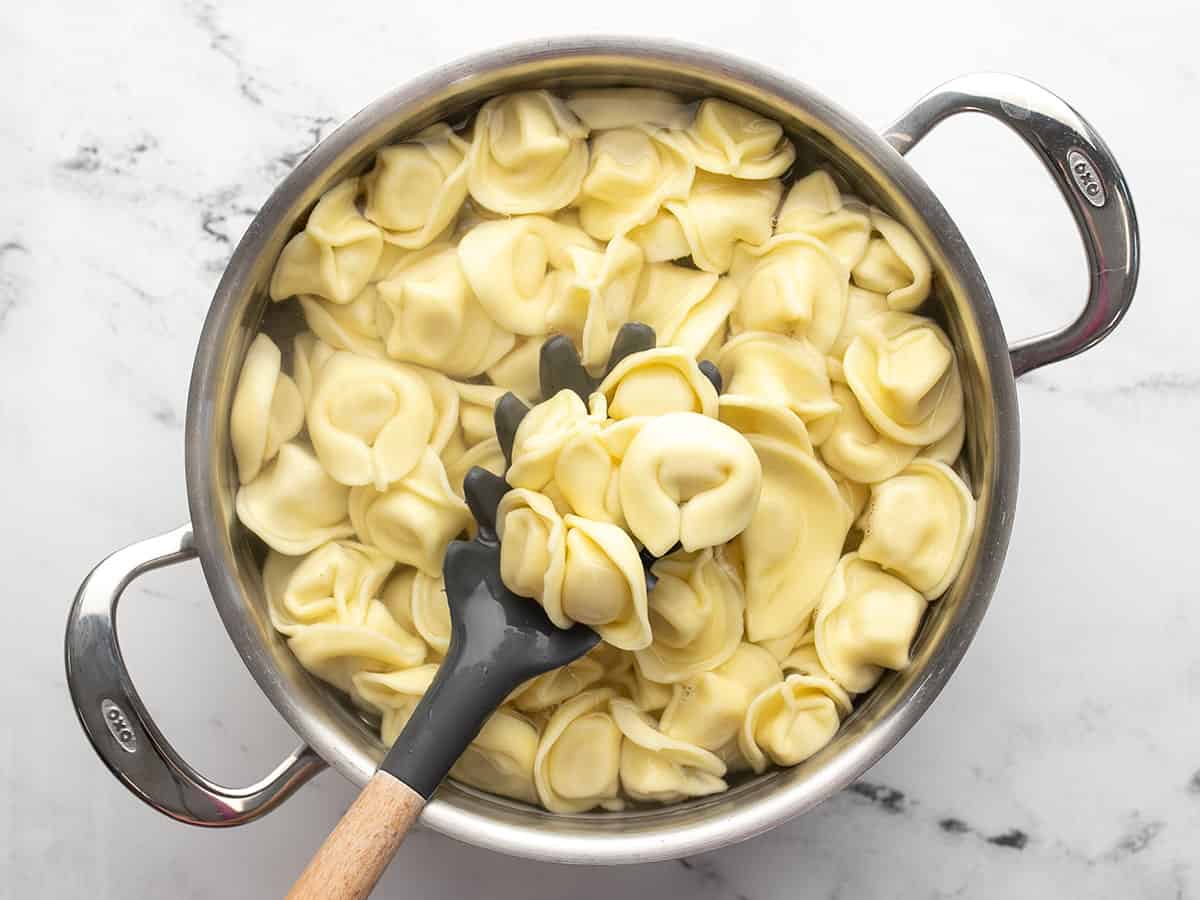
Meanwhile, bring a large pot of water to a boil over high heat. Once boiling, add 19oz. frozen cheese tortellini. Allow the tortellini to boil for about 3 minutes, or until it’s all floating (check the package directions for recommended cooking time). Drain the tortellini in a colander.
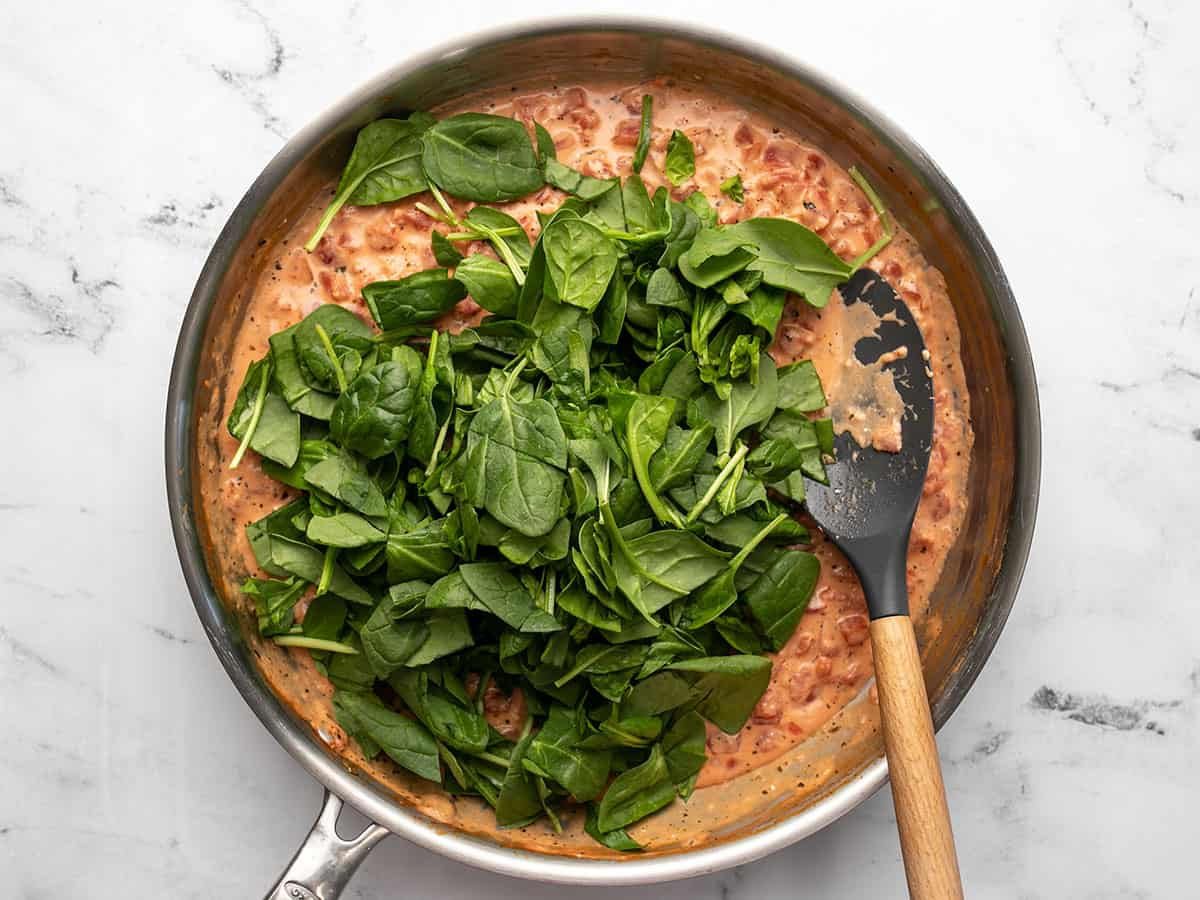
While the tortellini is draining, roughly chop about 2 cups of fresh spinach into bite-sized pieces. Add the chopped spinach to the sauce in the skillet and stir it in, allowing the heat to wilt the spinach.
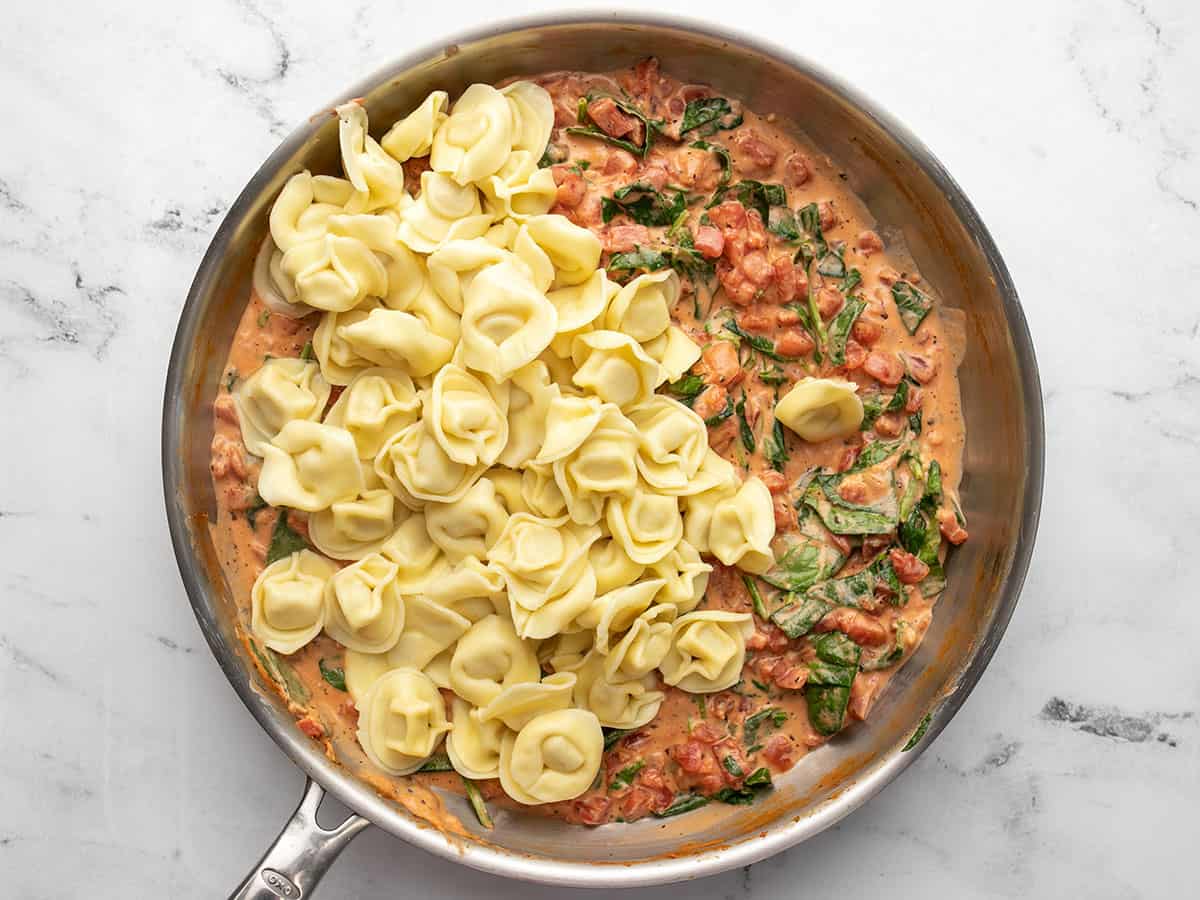
Add the drained tortellini to the skillet and stir to combine with the sauce.
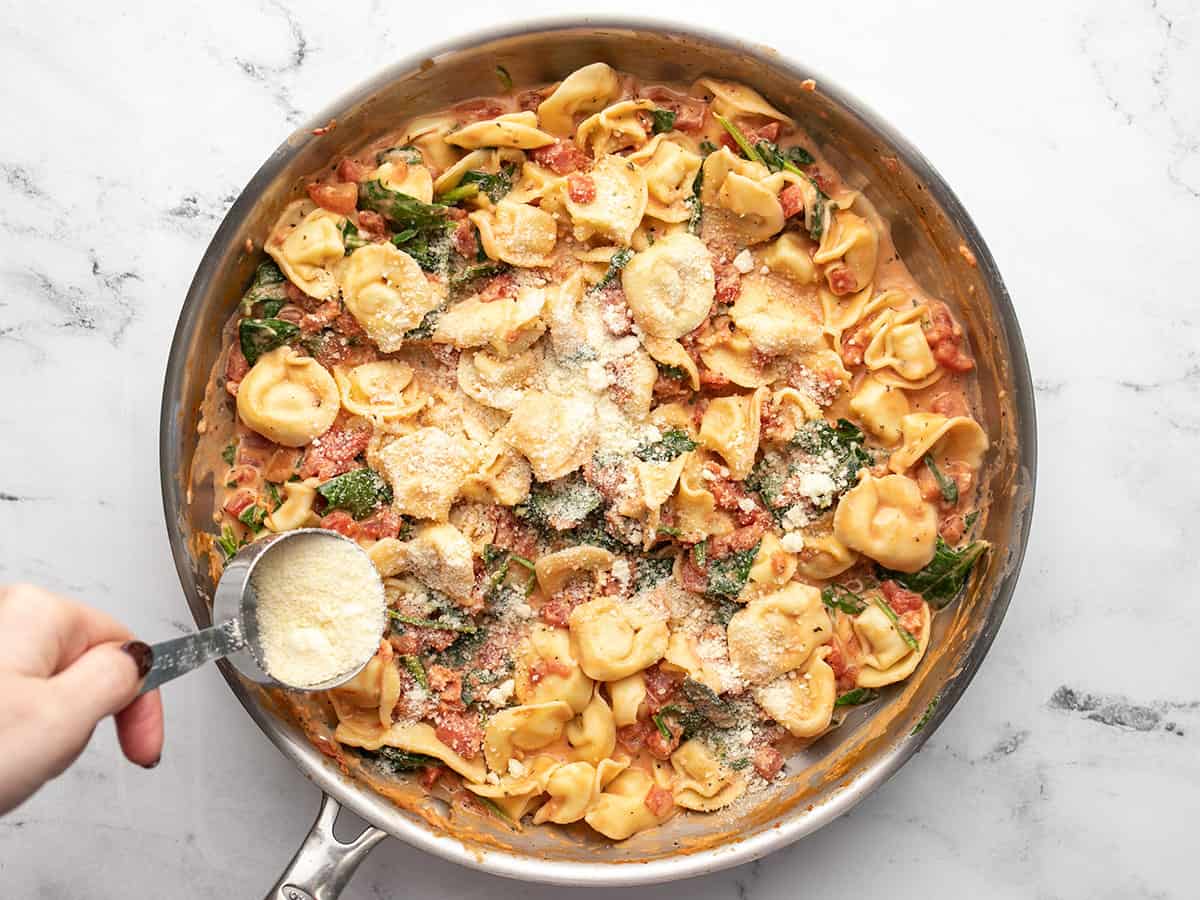
Sprinkle about ¼ cup Grated or shredded Parmesan over top, then stir to combine.
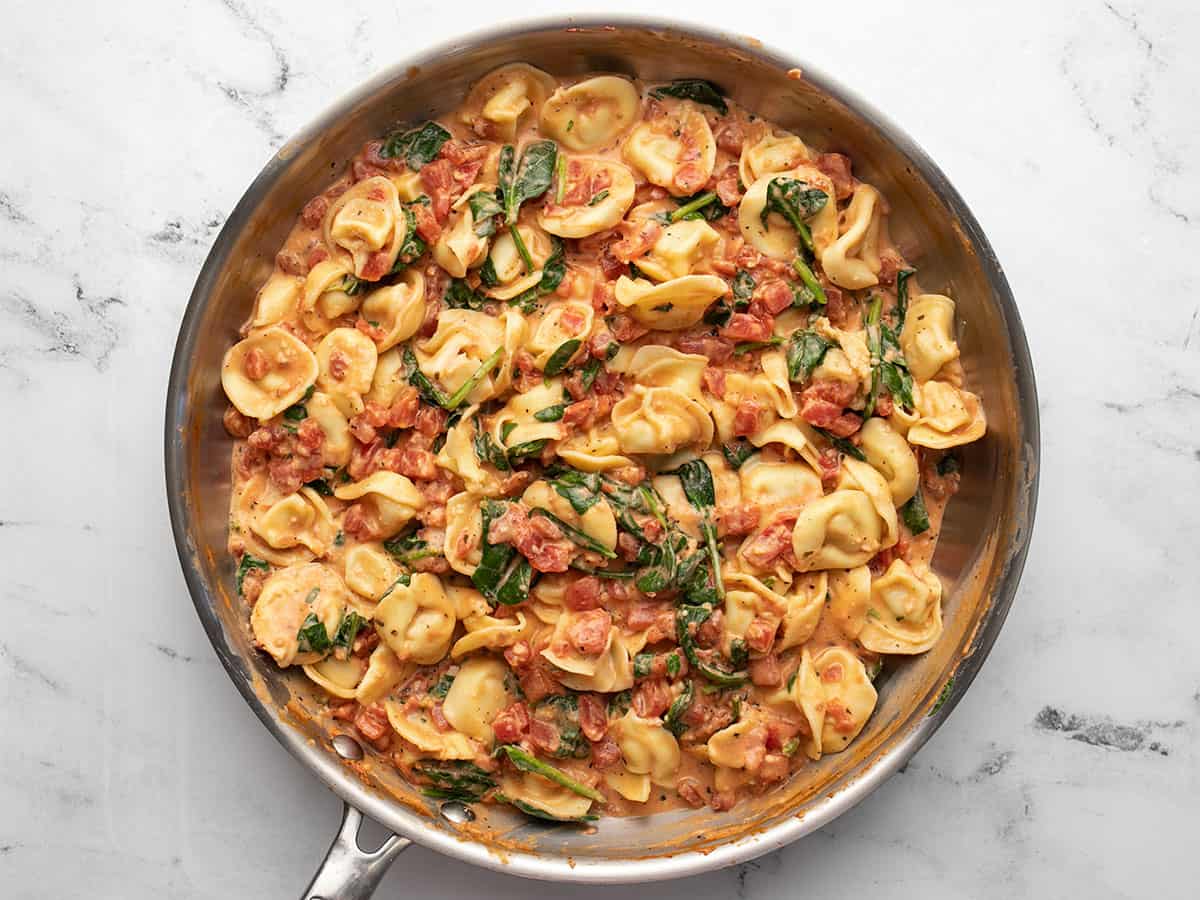
Give the tortellini one final taste and adjust the seasonings to your liking! We found that between the canned tomatoes, cream cheese, and Parmesan, no additional salt was needed for our taste buds. A pinch or two of crushed red pepper would also be awesome!

More Easy Skillet Meals


Creamy Salsa Chicken Skillet
$8.55 recipe / $2.14 serving
Beef Taco Skillet
$6.30 recipe / $1.58 serving
Pasta with Sausage and Peppers
$7.56 recipe / $1.93 servingThe post Spinach Tortellini Skillet appeared first on Budget Bytes.
By: Beth - Budget BytesTitle: Spinach Tortellini Skillet
Sourced From: www.budgetbytes.com/spinach-tortellini-skillet/
Published Date: Mon, 30 Jan 2023 15:39:33 +0000
Frequently Asked Questions
What spices assist in recovery?
The use of spices to aid in healing is an ancient practice dating back centuries. Many spices have been used for their medicinal properties, including ginger, cinnamon, cayenne pepper, turmeric, and garlic. Each of these spices has unique benefits that can help with various health issues.
Ginger is known for its anti-inflammatory and antioxidant effects and can help reduce inflammation in the body. It can also be used to soothe an upset stomach or relieve nausea.
Cinnamon has been found to have a wide range of medicinal properties, including antiseptic, antifungal, antimicrobial, and antioxidant agents. It is even believed to help regulate blood sugar levels, making it beneficial in helping prevent diabetes.
Cayenne pepper has been used for centuries as a natural pain reliever and anti-inflammatory agent. It is also thought to increase circulation and metabolism, which can help the body heal more quickly.
Turmeric is an herb that contains curcumin, a powerful antioxidant. Curcumin is beneficial in treating various conditions, from arthritis and neurological disorders to cancer.
Garlic is packed with nutrients and has many health benefits. It can help reduce inflammation, act as antibiotic, lower cholesterol levels, and even boost the immune system.
These spices are all-natural ways to help the body heal and improve overall health. They can all be easily incorporated into food or taken in supplement form for convenience. While spices alone won't cure any ailments, they can play an essential role in aiding healing.
In addition to spices, there are also other natural remedies for healing, such as herbs, essential oils, and homeopathy. Research has shown that many of these remedies can be effective in treating a variety of conditions. If you're looking for an alternative to conventional medicine, consider incorporating some of these natural remedies into your health routine.
What herb is best for healing?
Herbs are a fantastic way to help heal our bodies. Herbal medicine has been used since ancient times and continues to grow today. There are thousands of herbs known to cure various ailments.
Some herbs are excellent for treating colds and flu, while others can treat anxiety, depression, arthritis, cancer, diabetes, heart disease, and more.
There are also herbal remedies for skin care, hair loss, weight loss, sexual health, energy, sleep, digestion, and much more.
The list goes on and on. But one herb stands above them all regarding its ability to heal. That herb is called aloe vera.
Aloe Vera is considered to be the world's most powerful healer. For centuries it has helped people heal themselves naturally without any side effects.
It's incredible how well aloe vera works. It's even better than prescription drugs and surgery.
In addition to its natural healing properties, aloe vera is highly versatile and can be used in almost any area of life, including food, beauty products, and household cleaning supplies.
You may not realize this, but aloe vera contains hundreds of active compounds, which include vitamins A, C, E, B1, B2, B3, B6, folic acid, calcium, magnesium, iron, zinc, copper, sulfur, manganese, phosphorus, potassium, sodium, chloride, fluoride, iodine, selenium and more.
These nutrients are essential for human body functions such as cell growth, metabolism, immune system support, healthy bones and teeth, healthy blood pressure levels, healthy eyesight, healthy cardiovascular systems, healthy digestive systems, healthy lungs, healthy nervous system, healthy reproductive organs, healthy skin, and healthy libido.
Is it safe to eat raw garlic?
Raw garlic contains potent compounds that could cause stomach upset. Garlic should always be cooked before eating.
Garlic is one of the oldest known medicinal plants. It has been used since ancient times to treat various ailments.
Today, garlic is still commonly used for treating colds, coughs, and other respiratory infections. In addition, garlic can increase blood circulation, boost immunity, protect against cancer, lower cholesterol levels, prevent heart disease, and reduce stress.
Do not ingest large amounts of raw garlic to avoid possible health problems. It does not harm you if you consume small amounts regularly, however. This is especially true with young children who might accidentally swallow some.
How is basil used for medicinal purposes?
In ancient times, doctors would prescribe basil leaves to treat colds and coughs. Today, basil contains powerful anti-inflammatory properties, making it an ideal remedy for arthritis, asthma, bronchitis, eczema, gout, hay fever, indigestion, migraines, menstrual cramps, sinus infections, sore throats, ulcers, varicose veins, and more.
Basil is also known for its ability to help protect against cancer, heart disease, diabetes, skin conditions, and even aging.
Basil is often referred to as "the herb of grace" because it helps us relax and unwind after stressful situations. It is also said to improve memory and concentration, boost energy levels, increase libido, and enhance athletic performance.
The list goes on and on. Basil is a versatile plant that offers a wide range of benefits for our health and well-being.
Should You Use Herbs and Spices for Brain Health?
Herbs and spices have been used for centuries to improve brain health. Research shows that these natural remedies may help prevent dementia and Alzheimer's. Some herbs may even boost memory.
However, no scientific evidence proves that eating an herb-rich diet can keep your mind sharp. When it comes to improving cognitive function, there are more effective ways to do it.
One study found that older adults who took 1000 mg of vitamin B6 daily had fewer mental lapses than those taking placebo pills. Another study showed that drinking coffee could increase blood flow to the brain. Other studies suggest that exercise, socialization, and sleep improve brain health.
The bottom line is that herbs and spices probably won't make much difference to your overall health. But they might give you extra energy and focus, which can come in handy during the day.
Statistics
- Herbs are among the most popular and widely used medicinal remedies. According to a survey conducted by the National Institutes of Health, herbs were used by over 38% of adults in the United States.
- The global herbs market is expected to reach more than $125 billion by the end of 2025.
External Links
ncbi.nlm.nih.gov
- Antioxidant capacity of 26 spice extracts and characterization of their phenolic constituents - PubMed
- Cinnamon: A Multifaceted Medicinal Plant - PMC
mskcc.org
- Ashwagandha | Memorial Sloan Kettering Cancer Center
- Grape Seed | Memorial Sloan Kettering Cancer Center
en.wikipedia.org
amazon.com
How To
How To Upcycle Herbs After Making Infusions, Oils, Tinctures, And More?
There are more ways to use herbs than you might realize. This is why it's essential to keep an open mind when learning how to make herbal infusions, oils, tinctures, and more.
You'll find that there are many methods for making these products, and even though they may seem similar, each method has its benefits.
For example, some methods include creating decoctions, boiling water or alcohol with the herb(s), and letting them simmer for a while. These infusions are solid and potent because they contain higher concentrations of active compounds.
Another type of infusion includes macerating the herb(s), which means soaking them in liquid for a few hours or even overnight. Macerations tend to produce milder results because the plant material isn't boiled.
Some cold-infused forms involve steeping herbs in cool liquids such as ice cubes or cold water. Cold infusions are gentler than hot ones, often used to treat minor ailments.
Herbal oil extraction involves heating the herb(s) to release the essential oils. You can either do this yourself or have someone help you out with it.
Finally, there are tinctures made by mixing herbs with alcohol. They're usually taken orally and are very effective for treating coughs, colds, and flu symptoms.
The best way to learn how to create infused products is to experiment with various techniques. Each technique offers a different potency and effectiveness, depending on the herb(s) you choose.
Once you've tried a few different methods, you'll begin to develop your preferences. In time, you'll be able to determine which techniques work well for you and which aren't worth pursuing.
Did you miss our previous article...
https://belovedsaffron.com/recipes/homemade-vegetarian-chili
.png)





